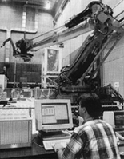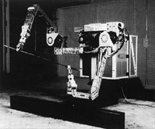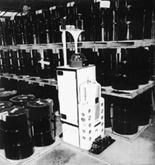

The Department of Energy faces the enormous task of cleaning up radioactive waste and harmful chemicals accumulated during years of nuclear weapons production at sites across the country. In many cases, it's too expensive and too dangerous for humans to go near the waste or chemicals. Even if people could safely do some jobs, there aren't enough skilled technicians to do the work. On the other hand, robots can work with contaminated materials without special training, and they don't mind working around the clock on repetitive tasks.
The Department of Energy's Office of Environmental Management, which is responsible for managing the cleanup of DOE waste from past weapons production and current operations, plans to bring DOE sites into regulatory compliance by 2019. DOE's Robotics Technology Development Program has been working with industry and academia to develop the practical machines that will help the department reach its goal.
 DOE's robotics program is
under the direction of Linton Yarbrough, a former physics and
chemistry professor who approached his discussion with Initiatives interviewers
Judy Schwab and Elaine Specht much like a teacher would speak
with students who stopped by his office for extra help after a lecture.
DOE's robotics program is
under the direction of Linton Yarbrough, a former physics and
chemistry professor who approached his discussion with Initiatives interviewers
Judy Schwab and Elaine Specht much like a teacher would speak
with students who stopped by his office for extra help after a lecture.
Robotics Program Philosophy
Yarbrough began the session by sharing his three-part philosophy
for managing the DOE robotics program. First, it's a national
program that does not focus on a particular site within DOE.
"I work on problems that have complex-wide implications,"
he explained. For example, waste will need to be retrieved from
tanks at a number of DOE sites including Oak Ridge, Savannah,
Fernald, West Valley, and Hanford. But rather than build a system
to retrieve Hanford tank waste, the robotics program is building
a system for retrieving tank waste in general. Yarbrough said,
"I pick the hard problem. If I can solve the hard one, the
easy ones will come along." Keeping a national focus has its drawbacks,
though. "It's very difficult because every site believes its
problem is most significant, so we may step on some toes,"
Yarbrough said.
The second part of Yarbrough's philosophy is that the robotics program needs to build multi-laboratory teams in conjunction with industry and universities. Although the five robotics program coordinators are at DOE sites, they have work going on at other sites and they collaborate on technology development with universities and industries. Yarbrough says, "Somewhere between 55 and 60 percent of my budget goes to private industries and universities. As far as I can find out, the robotics program within the Office of Technology Development is currently funding the largest robotics research effort in the whole country in terms of involvement with industries and government and certainly in terms of university-funded work."
The third part of Yarbrough's philosophy is that he works on significant and hard, but do-able problems. "We do not put on lots of flashy bells and whistles. The machines are simply designed to do what all robots do and that is to duplicate to a greater or lesser degree a human capability."
To solve the significant, but do-able, problems in a national program with involvement from industry and universities, Yarbrough has divided the robotics program into five technical application areas that address needs common to multiple DOE sites.
Tank Waste Retrieval
One particularly difficult problem Yarbrough believes robots can
solve is removing nuclear weapons production byproducts from
underground storage tanks. DOE wants to take the waste out of the
tanks and store or dispose of it safely. Because of the way they
were constructed, the tanks at DOE's Hanford, Washington site
will be the most challenging. Hanford began storing waste in its 177
steel-lined, concrete tanks in 1943. As much as 23 meters across
and 10 meters high, the tanks are like 200,000 liter underground
birthday cakes containing layers of waste ranging from thick sludge
the consistency of soft mud to saltcake similar to crumbling
concrete. Yarbrough asked, "How do you build a machine that
not only sucks up nasty sludge, but can chew through
concrete?" To make the task even more challenging, the
opening on the top of each tank is little more than one meter
across. The opening cannot be widened and pressure cannot be
placed on the top of the tanks without threatening their
structural integrity. Yarbrough, by now in full teaching mode,
fired off more questions, "How do you get a machine into a
hole only one meter around and have it reach all the way to the
bottom to bust the waste loose? You have not only an extension
problem, but you have to have enough power at the end to lift
something. What good does it do if we get this machine in there and
it can only lift a teacup? It would take a zillion years to clean
these tanks out."
To try to find answers to these questions, the robotics program is building a test bed facility at Hanford that contains half of a full-sized tank model. A support platform will be built above the model with a large insertion mast (a series of nested tubes that can go up and down) and a long-reach arm fitted with a dexterous manipulator that will go into the tank model to break up simulated waste. Sensors will help operators direct the arm's movement while inside the tank. After the waste is broken up, other attachments, like a high-powered vacuum cleaner, will be used to retrieve the waste. Removed waste will be pumped into processing tanks for further treatment before final disposition.
Contaminant Analysis Automation 
Imagine the exposure problems for chemists and technicians analyzing
soil samples containing PCBs, plutonium, chromium, or other
hazardous chemicals. DOE estimates it will soon require 10 million
such analyses each year. That's three to five times more than are
being done today. At $300 per sample, the cost would quickly
reach into the billions. What's more, there aren't enough laboratories
and trained technicians to handle that volume of work. DOE's contaminant
analysis automation team is working on a standardized laboratory analysis
system for automating the characterization procedures to help
solve these problems. Yarbrough said, "In my opinion, in
terms of solving the Department of Energy's problems, CAA is
probably the most critical thing the robotics group does, simply because
none of the problems can be solved until you've run the analysis and
know what you've got. And none of the treatment methods will take place
until you can characterize what's coming in and what's going
out."
"We're trying to automate the whole process from the time a sample comes in the door to the time the report is written. We may not be able to automate all of it, but if we can automate four or five specific analytical procedures, we will have covered 70 to 80 percent of DOE's analysis needs."
Automated laboratories could be located at numerous DOE sites, eliminating the concerns associated with transporting samples that may contain high-level radiation. But, Yarbrough pointed out, the Department of Energy is not in the manufacturing business. DOE will rely on private industry to build the automated sampling machines DOE needs at its sites. According to Yarbrough, the DOE market for the systems is small compared to the market for private industry. "Everything that is produced goes through some quality control analysis," he explained. "Maybelline has to analyze its mascara, and if I can analyze soil for volatile organics, I can analyze mascara for volatile organics. What I'm trying to do is solve a DOE problem, but the companies can see selling millions of these things." The robotics program is currently seeking industrial partners to build individual pieces of the system and will be looking at a larger company to integrate the whole system on a commercial basis.
Mixed Waste Operations
DOE has an enormous amount of mixed waste to handle. Right now,
there are more than 169,000 cubic meters of mixed low-level waste
and 58,000 cubic meters of transuranic waste at DOE sites. Operations
and environmental restoration projects are expected to generate
an additional 900,000 cubic meters of mixed low-level waste in
the next five years. Because much of that waste will have to be
moved for storage, treatment, or disposal, the robotics program's
mixed waste operations team works with industry and universities to
develop and demonstrate material handling and characterization technologies.
 One way
DOE moves waste dangerous to humans is by overhead crane. A cable
and hook hang down from the crane to pick up and move objects,
but when the crane moves, the cable begins to swing. "Think
of picking a rock up with a piece of string," Yarbrough said
as he scanned his office for a way to illustrate his point. "When
you start walking, what happens to it?" The swing-free crane
control system under development by the mixed waste operations team
will stop objects being moved by the crane from swinging, a
definite advantage when hauling around a drum full of high-level
liquid waste. The crane has sensors that detect the period of the
cable's swing. Understanding what Yarbrough calls "a simple
freshman physics problem, the law of the pendulum," the team has
developed a way to force the crane to go in the opposite
direction of the pendulum swing to cancel out any movement by the cable.
The swing-free crane is much safer and a great time saver.
According to Yarbrough, "When you pick up a load and you
move it by a traditional crane, you've got to wait for it to stop
swinging. We've got film showing that you lift up a single drum and
it takes an hour just to stop swinging before you can move
it." With the swing-free crane robot, the swinging will be stopped
in the snap of a finger. There are several crane companies
actively seeking to work with DOE on the swing-free crane. Now,
DOE is trying to develop a system to make it more versatile by
programming it to stop the cable from swinging as its length changes.
When the pendulum length changes, the period of the swing
changes, and the crane will need to compensate.
One way
DOE moves waste dangerous to humans is by overhead crane. A cable
and hook hang down from the crane to pick up and move objects,
but when the crane moves, the cable begins to swing. "Think
of picking a rock up with a piece of string," Yarbrough said
as he scanned his office for a way to illustrate his point. "When
you start walking, what happens to it?" The swing-free crane
control system under development by the mixed waste operations team
will stop objects being moved by the crane from swinging, a
definite advantage when hauling around a drum full of high-level
liquid waste. The crane has sensors that detect the period of the
cable's swing. Understanding what Yarbrough calls "a simple
freshman physics problem, the law of the pendulum," the team has
developed a way to force the crane to go in the opposite
direction of the pendulum swing to cancel out any movement by the cable.
The swing-free crane is much safer and a great time saver.
According to Yarbrough, "When you pick up a load and you
move it by a traditional crane, you've got to wait for it to stop
swinging. We've got film showing that you lift up a single drum and
it takes an hour just to stop swinging before you can move
it." With the swing-free crane robot, the swinging will be stopped
in the snap of a finger. There are several crane companies
actively seeking to work with DOE on the swing-free crane. Now,
DOE is trying to develop a system to make it more versatile by
programming it to stop the cable from swinging as its length changes.
When the pendulum length changes, the period of the swing
changes, and the crane will need to compensate.
Decontamination and Dismantlement
As with mixed waste handling, the threat of radiological
contamination and exposure to harmful chemicals will require many
of the deactivation, surveillance, and maintenance activities to
be performed remotely with robots as DOE decontaminates and
dismantles its facilities. Yarbrough put the problem in
perspective by asking, "Would you like to volunteer to put
on a C [contamination] -suit and go into the F-canyon* and start
ripping out pipes not knowing what's in those pipes? You could do
it with a human, but it's extremely dangerous, and there are some
areas that are so hot that even C-suits will not protect a guy.
It's not just the safety aspect, it's the idea that this is the only
way to do some of these tasks."
 To aid in
dismantlement, DOE is working on a dual-arm work module that uses
multiple cooperating robots. These robots work much like two
people pruning a tree when one person cuts off limbs while the other
one holds them until they're cut and carries them to the brush
pile. When tearing pipe out of a hot cell canyon, the dual arm
module works on an overhead crane system that can move left and
right, forward and back, and up and down. All the canyons already
have overhead cranes, Yarbrough explained, so after installing
the cooperating robots, they can work together to take out contaminated
pipes carrying unknown materials.
To aid in
dismantlement, DOE is working on a dual-arm work module that uses
multiple cooperating robots. These robots work much like two
people pruning a tree when one person cuts off limbs while the other
one holds them until they're cut and carries them to the brush
pile. When tearing pipe out of a hot cell canyon, the dual arm
module works on an overhead crane system that can move left and
right, forward and back, and up and down. All the canyons already
have overhead cranes, Yarbrough explained, so after installing
the cooperating robots, they can work together to take out contaminated
pipes carrying unknown materials.
 Another
robot in development assists with waste characterization and
stored waste inspection. The Department of Energy has tens of
thousands of drums of waste stacked several high in warehouses.
The Environmental Protection Agency and the U.S. government say
the drums must be inspected weekly, a tedious job that would
require someone to hold a sensor one inch off the floor while
slowly walking up and down the aisles. Instead, the robotics
program developed SIMON (Semi-Intelligent Mobile Observing
Navigator) to go up and down aisles at a speed of one inch per
second carrying a radiation counting monitor. If contamination is
detected, SIMON stops and sounds an alarm. According to Yarbrough,
"The first time this machine was put into a building at DOE's Savannah
River, something like 35 to 40 hot spots were found on the floor. They
had been missed for 25 or 30 years by the humans. They were not screaming
hot, but with the reduced levels of radiation allowed in
buildings, it's important to find even the very low hot spots.
And we got'em first time out."
Another
robot in development assists with waste characterization and
stored waste inspection. The Department of Energy has tens of
thousands of drums of waste stacked several high in warehouses.
The Environmental Protection Agency and the U.S. government say
the drums must be inspected weekly, a tedious job that would
require someone to hold a sensor one inch off the floor while
slowly walking up and down the aisles. Instead, the robotics
program developed SIMON (Semi-Intelligent Mobile Observing
Navigator) to go up and down aisles at a speed of one inch per
second carrying a radiation counting monitor. If contamination is
detected, SIMON stops and sounds an alarm. According to Yarbrough,
"The first time this machine was put into a building at DOE's Savannah
River, something like 35 to 40 hot spots were found on the floor. They
had been missed for 25 or 30 years by the humans. They were not screaming
hot, but with the reduced levels of radiation allowed in
buildings, it's important to find even the very low hot spots.
And we got'em first time out."
Cross-Cutting and Advanced Technology
Many of DOE's robotics needs can be met by or modified from
existing technologies developed and being used by universities,
industry, and other federal agencies. The cross-cutting and
advanced technology group works with researchers outside DOE to
avoid duplicating existing technology. The group also works to
transfer the technologies developed by DOE's robotics group to
industry for commercialization. Obtaining commercially available robot
components from different sources can create a problem when combining
them into one system. There is also the problem of ensuring that one step
is complete in time for the next so the cross-cut group
coordinates schedules and administers projects to be sure
everything fits together and meets time lines.
The graphical programming interface, something that all systems in the robotics program use, was developed by the cross-cut group. Robots will be used to help clean up places on DOE sites that humans can't go near. "How do you drive the robot around a world that you can't see?" Yarbrough joked, "Have a guy open up the top of the Hanford tanks, stick his head in there and say, 'Move right three feet'?"
"Bring in lights and a camera," one interviewer suggested, as if called on in class.
Yarbrough replied, "If you had a camera on the end of the arm, all you could do is look where that camera was [looking]." The solution, Yarbrough explained, is similar to a high-tech virtual reality game. A robot equipped with sensors can scan in all directions and build a mathematical model of its environment. As hazardous and radioactive waste is removed from the room or tank the robot is helping to clean up, the sensor will re-scan and automatically build a new model. "With the virtual world," Yarbrough said, "you just click on a couple places and instead of looking out from the end of an arm, you're looking down on the robot. You can alter your reference position at will to accomplish a difficult task."
Another good reason for developing everything with graphics control is to train operators. Robotics technology will cost DOE, in Yarbrough's words, "a chunk a change." If DOE pays millions of dollars for a robot to do a specific task, how can many people be trained to operate it? "You don't train them to operate the actual machine," Yarbrough said answering his own question. "You train them to operate the graphics model." A training facility where students operate imaginary equipment by computer is much less expensive than practicing on the real thing, and it exactly duplicates what the actual operators would see on their computer screens.
As Yarbrough wrapped up the interview/help session, he explained the necessity of robots in DOE's cleanup operations by citing a similar scenario. "It's like the question, what's a better way to send a man to the moon besides a rocket?" The interviewers pondered this question like good students and with no answer, found themselves right.
"There is no other way," Yarbrough said.
![]()